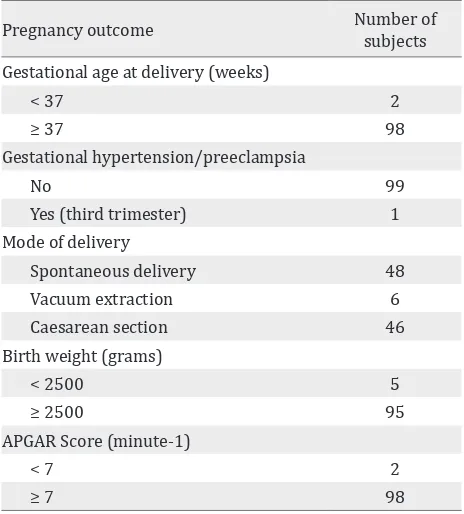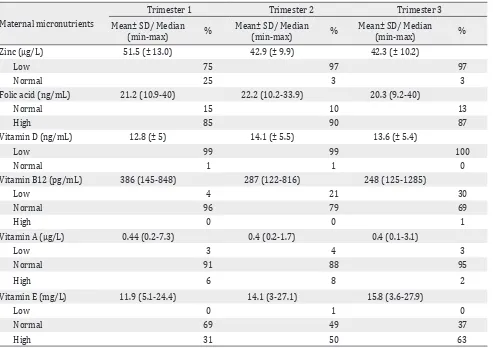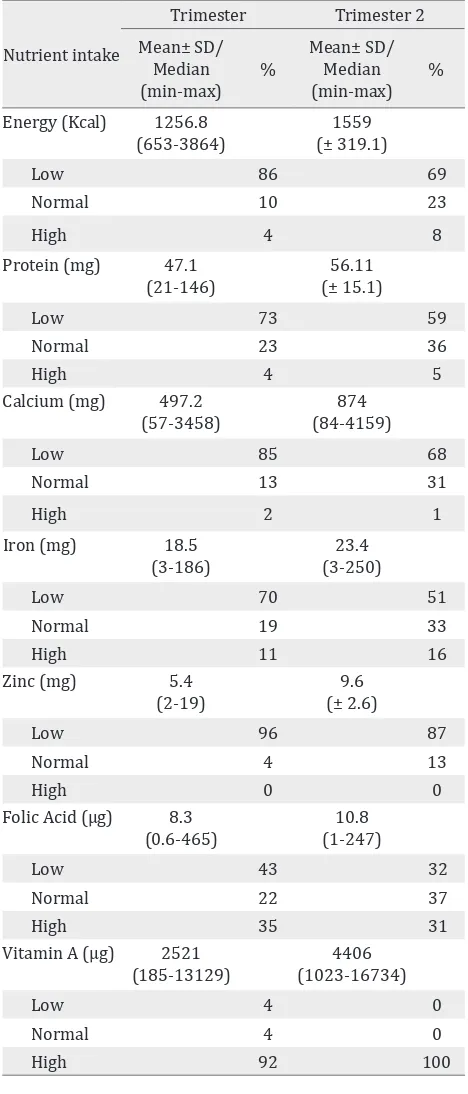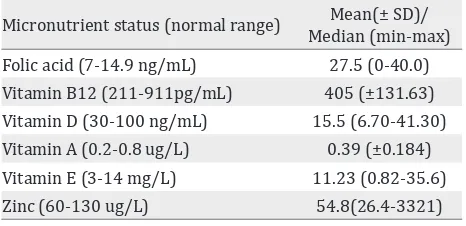The effect of multi-micronutrient and protein supplementation on
iron and micronutrients status in pregnant women
Keywords: anemia, iron status, micronutrients, vitamin
pISSN: 0853-1773 • eISSN: 2252-8083 • http://dx.doi.org/10.13181/mji.v24i3.1209 • Med J Indones. 2015;24:168-75 • Received 20 Feb 2015 • Accepted 19 Aug 2015
Correspondence author: Noroyono Wibowo, [email protected]
Copyright @ 2015 Authors. This is an open access article distributed under the terms of the Creative Commons Attribution-NonCommercial-ShareAlike 4.0 International License (http://creativecommons.org/licenses/by-nc-sa/4.0/), which permits unrestricted non-commercial use, distribution, and reproduction in any medium, provided the original author and source are properly cited.
Noroyono Wibowo, Rima Irwinda
Department Obstetrics and Gynecology, Universitas Indonesia, Cipto Mangunkusumo Hospital, Jakarta, Indonesia
C l i n i c a l Re s e a rc h
ABSTRAK
Latar belakang: Keuntungan suplementasi multi mikronutrien semakin mendapat perhatian melihat banyaknya ibu hamil dengan status nutrisi yang suboptimal, namun rendahnya kepatuhan mengurangi efektivitas dari program suplementasi besi-asam folat yang dicanangkan pemerintah. Tujuan studi ini adalah untuk menilai efektivitas suplementasi multi-mikronutrien dan protein pada status besi dan multi-mikronutrien wanita hamil.
Metode: Studi eksploratif dilakukan pada 100 wanita hamil
selama ≤ 12 minggu yang melakukan asuhan antenatal di
Rumah Sakit Budi Kemuliaan, Jakarta. Susu formula yang mengandung multi-mikronutrien dan protein diberikan setiap bulan hingga persalinan. Pemeriksaan antropometri, darah
maternal dan tali pusat, ultrasonografi (USG), dan dietary recall merupakan variabel yang dinilai. Data dianalisis menggunakan uji korelasi. Korelasi antar variabel diuji menggunakan uji Pearson atau Spearman.
Hasil: Kadar hemoglobin mengalami penurunan secara
signifikan (p < 0,001), dengan kadar terendah pada trimester 2. Kadar pada tiap trimester secara berurut adalah 12,16 ± 1,03 g/dL; 12 menderita anemia, dan 17 memiliki kadar feritin yang rendah, 10,85 ± 0,95 g/dL; 58 menderita anemia, dan 69 memiliki kadar feritin yang rendah, dan 11,02 ± 0,35 g/dL; 50
menderita anemia dan 51 memiliki kadar feritin yang rendah. Kadar feritin dan besi serum juga turun pada trimester satu
dan dua (p < 0,001). Kadar seng dan vitamin D juga mengalami
penurunan. Anemia tidak mempengaruhi luaran kehamilan seperti persalinan preterm, preeklamsia, atau berat badan lahir rendah.
Kesimpulan: Kadar hemoglobin, feritin, besi, seng, dan vitamin D maternal selama kehamilan tidak dapat dipertahankan atau ditingkatkan dengan suplementasi multi-mikronutrien dan protein.
ABSTRACT
Background: Potential benefits of multiple micronutrient supplements has become an increasing interest seeing as the high rate of pregnant women with suboptimal nutritional status, but low compliance often reduces effectiveness of large-scale iron and folic acid supplementation program. The aim of this study was to investigate the efficacy of multi-micronutrient and protein supplementation on iron and micronutrients status in pregnant women.
Methods: An exploratory study was conducted to 100 pregnant women ≤ 12 weeks, who underwent antenatal care in Budi Kemuliaan Hospital, Jakarta. The subjects received formulated powder milk containing multi-micronutrient and protein supplement monthly until delivery. Anthropometric measurement, maternal and cord blood exam, ultrasound and dietary recall were done. The data was analyzed by correlation test. Correlation between variables was tested using Pearson or Spearman correlation test.
Results: The mean maternal hemoglobin level significantly decreased during study (p < 0.001), being the lowest in second trimester. The levels on the first, second, and third trimester respectively was 12.16 ± 1.03 g/d; 12 anemic subjects and 17 had low ferritin level, 10.85 ± 0.95 g/dL; 58 anemic subjects and 69 had low ferritin level, and 11.02 ± 0.35 g/dL; 50 anemic subjects and 51 had low level of ferritin). Ferritin and serum iron levels were decreased at trimester one and two (p < 0.001), also the zinc and vitamin D level declined. Anemia did not correlate with pregnancy outcomes such as preterm delivery, preeclampsia, or low birth weight.
Many women have suboptimal nutritional status and insufficient intake during pregnancy, which leads to an increased risk to develop anemia and micronutrients deficiency. The World Health Organization (WHO) estimates from 35-75% of pregnant women in developing countries, including 37.1% in Indonesia, are anemic.1-4 Current knowledge indicates that iron deficiency anemia and micronutrients deficiency in pregnancy are risk factors for miscarriage, congenital anomaly, preeclampsia, gestational diabetes, preterm delivery and subsequent intrauterine growth restriction or low birth weight, and possibly correlated with neonatal health with its long-term outcome.4-6 There has been an increasing interest in the potential benefits of multiple micronutrient supplements. Low compliance often reduces the effectiveness of large-scale iron and folic acid supplementation program. Milk powder consists of multi-micronutrient and protein supplementation is expected to give better compliance hence, will be more effective. The aim of this study was to investigate the efficacy of multi-micronutrient and protein supplementation on iron and micronutrients status in pregnant women.
METHODS
This is an exploratory study with open single group. The study was conducted at Budi Kemuliaan Hospital, Jakarta, to 100 pregnant
women ≤ 12 weeks pregnancy who underwent
antenatal care. The inclusion criteria were
women with ≤ 12 weeks of pregnancy and no
congenital anomaly (confirmed by ultrasound examination), willing to participate, not on other pregnancy milk/multi-micronutrient supplementation, and was not enrolled in any other interventional study. The exclusion criteria were subjects with hyperemesis gravidarum, women with intrauterine fetal death, abortion, or did not consume the product within a week.
This study was conducted between February 2012 until April 2013. The protocol used in this study was approved by the Ethical Committee For Research In Human from the Faculty of Medicine, Universitas Indonesia (No. 480/PT02. FK/ETIK/2012).
Subjects were asked to fill out a questionnaire
to obtain data on their general and family characteristics, current illnesses, and dietary
intake upon their first visit. Anthropometric
measurement, ultrasound examination, and blood exam were done. Products were given to subjects monthly, and the compliance was monitored
by trained field assistants randomly by phone.
The product used in this study was formulated powder milk, adapted to the additional need of Indonesian pregnant women. It was packed in 150 g alufoil in a folding box. Spoon was provided in each pack/box to ensure accurate dilution of the product. Its ingredients per 200 ml serving were folic acid 471 mg, Fe 15.9 mg, Ca 360 mg, P 186 mg, Mg 36 mg, Na 78 mg, K 240 mg, Cl 139.5 mg, Zn 4.1 mg, vitamin A 1545 IU, vitamin D 105
IU, Vitamin E 1.8 IU, thiamin 750 mg, riboflavin
750 IU, pyridoxine 1650 mg, cobalamin 1.56 mg, vitamin C 48 mg, biotin 5.7 mg, niacinamide 2.4 mg, pantothenic acid 1.05 mg, choline 26.7 mg and docosahexaenoic acid (DHA) 15 mg. Study parameters were anthropometric status, maternal hemoglobin, erythrocyte, hematocrit, mean corpuscular volume (MCV), serum iron, ferritin, high sensitivity c-reative protein (hsCRP), vitamin D, A, B12, E, zinc, folic acid, and albumin level, dietary intake, pregnancy complication (preterm and preeclampsia), babies’ birth weight, and appearance, pulse, grimace, activity and respiration (APGAR) score, and iron, micronutrients and status of the cord blood.
Blood test and ultrasound examination data were collected three times; at baseline, three months after supplementation and before delivery. Immediately after birth, the cord blood was collected. The dietary recall was recorded twice; at baseline and three months after supplementation using 24-hours food recall by trained nutritionists.
RESULTS
A total of 100 of 124 subjects completed the study. Of those who dropped out, 14 subjects refused to complete the study, 10 subjects did not consume the product within a week consecutively. There were 89, 84, and 72 subjects who consumed the products once daily in trimesters one, two, and
three, respectively. As many as five, seven and 21
subjects did not consume the products less than three times in trimesters one, two, and three. The subjects who did not consume the products 3-7 times/week were six, nine and seven subjects in trimesters one, two and three.
The characteristics of the subjects and pregnancy outcomes are shown in tables 1 and 2. The mean age of the subjects was 29 year old. Sixty percent of subjects had normal body mass index, and 81%
had mid-upper arm circumference ≤ 23.5 cm.
Normal weight gain during pregnancy was found in 46% subjects.
Most of subjects delivered their babies in ≤ 37 weeks (98%), 95% with birth weight ≤ 2,500 g (95%), and APGAR score ≤ 7 (98%). Only one
subject had gestational hypertension.
Maternal anemia, iron, micronutrient and vitamin status
The mean maternal hemoglobin level in the first
trimester was 12.16 ± 1.03 g/dL, 12 subjects had anemia, and 17 subjects had low ferritin level (<20 g/dL). In the second trimester, the mean maternal hemoglobin level was 10.85 ± 0.95 g/dL. Fifty-eight subjects had anemia and 69 subjects had low ferritin level. We found maternal hemoglobin level in the third trimester was 11.02 ± 0.35 g/dL, 50 subjects had anemia and 51 subjects had low level of ferritin. Subjects who were anemic and/ or had low ferritin level, were given additional ferrous fumarate 360 mg supplementation. The number of subjects who consumed additional iron supplementation was 19, 79, and 93 subjects in trimesters one, two and three. Respectively the maternal iron, micronutrient and vitamin status are shown in tables 3 and 4.
Significant correlation was found between
hemoglobin and vitamin B12 level in trimester two (r = 0.157; p = 0.042). However, no correlation was found between hemoglobin level with folic
Characteristics of the subjects n (%) Education
Elementary school 4
Junior high school 7
Senior high school 59
Diploma 18
University 12
Occupation
Housewives 42
Working 58
Body mass index (kg/m2)
Underweight (<18.5) 12
Normal (18.5-24.9) 60
Overweight (25-29.9) 25
Obese (≥30) 3
Maternal weight gain during pregnancy
Low 36
Normal 46
Over 18
Gravida
Primi 38
Multi 62
Table 1. Characteristics of the subjects (n=100)
Table 2. Pregnancy outcome
Pregnancy outcome Number of subjects Gestational age at delivery (weeks)
< 37 2
≥ 37 98
Gestational hypertension/preeclampsia
No 99
Yes (third trimester) 1
Mode of delivery
Spontaneous delivery 48
Vacuum extraction 6
Caesarean section 46
Birth weight (grams)
< 2500 5
≥ 2500 95
APGAR Score (minute-1)
< 7 2
≥ 7 98
Iron Status
Trimester 1 Trimester 2 Trimester 3
Mean ± SD/ Median
(min-max) %
Mean ± SD/ Median
(min-max) %
Mean ± SD/ Median
(min-max) %
Hemoglobin (g/dL) 12.2 ± 1.0 10.9 ± 1 11.0 ± 0.4
Anemia 12 58 50
Normal 88 42 50
Ferritin(μg/L) 65.2 (4-410.4) 12.5 (3.9-216) 16.1(4-312)
Deficiency 17 69 51
Insufficiency 15 14 30
Normal 68 17 19
MCV(fL) 85.2 (65.1-94.4) 88.6 (69.7-98.2) 85.8 (61.9-93.2)
Low 13 6 15
Normal 87 94 85
Erythrocyte (x106/μL) 4.3 (± 0.4) 3.73 (± 0.3) 4.01 (± 0.4)
Low 7 61 32
Normal 93 39 68
Serum iron (μg/L) 167.2 (39-3772) 137.5 (22-2231) 222.0 (21-3042)
Low 53 55 56
Normal 37 42 40
High 10 3 4
Table 3. Maternal iron status
Table 4. Maternal micronutrient and vitamin status
Maternal micronutrients
Trimester 1 Trimester 2 Trimester 3
Mean± SD/ Median
(min-max) %
Mean± SD/ Median
(min-max) %
Mean± SD/ Median
(min-max) %
Zinc (μg/L) 51.5 (± 13.0) 42.9 (± 9.9) 42.3 (± 10.2)
Low 75 97 97
Normal 25 3 3
Folic acid (ng/mL) 21.2 (10.9-40) 22.2 (10.2-33.9) 20.3 (9.2-40)
Normal 15 10 13
High 85 90 87
Vitamin D (ng/mL) 12.8 (± 5) 14.1 (± 5.5) 13.6 (± 5.4)
Low 99 99 100
Normal 1 1 0
Vitamin B12 (pg/mL) 386 (145-848) 287 (122-816) 248 (125-1285)
Low 4 21 30
Normal 96 79 69
High 0 0 1
Vitamin A (μg/L) 0.44 (0.2-7.3) 0.4 (0.2-1.7) 0.4 (0.1-3.1)
Low 3 4 3
Normal 91 88 95
High 6 8 2
Vitamin E (mg/L) 11.9 (5.1-24.4) 14.1 (3-27.1) 15.8 (3.6-27.9)
Low 0 1 0
Normal 69 49 37
Nutrition intake and albumin level
Food frequency questionnaire (FFQ) showed many subjects had low nutrition intake including energy, protein, calcium, iron, and zinc intake. There was negative correlation between iron serum in second
trimester with iron intake in first trimester (p =
0.353), and hemoglobin level in third trimester with iron intake in second trimester (p = 0.067; r =
Table 5. Maternal nutrient intake during the study Table 6. Cord blood iron status
-0.151). Maternal nutrients intake during study are shown in table 5.
The mean albumin levels were 3.90 ± 0.27; 3.43 ± 0.24, and 3.37 ± 0.28 g/dL, in trimesters one, two, and three. Respectively the total number of subjects
who had low albumin level was significantly
increased during study. The subjects number 3, 46, and 62 had low albumin levels in trimesters
one, two, and three. Significant correlation was
found between hemoglobin and albumin level in trimester two (r = 0.259; p = 0.007) and trimester
three (r = 0.240; p = 0.011), but no significant
correlation was found between hemoglobin and albumin level in trimester one.
Cord blood iron status and maternal iron status
The mean cord blood hemoglobin level was 13.24 ± 1.93 g/dL and 56% had low hemoglobin level. No correlation was found between cord blood hemoglobin level and maternal hemoglobin level in trimesters one, two, and three (p > 0.05).
No correlation was found between cord blood
and maternal hemoglobin level in first trimester
Nutrient intake Energy (Kcal) 1256.8
(653-3864)
Protein (mg) 47.1 (21-146)
Calcium (mg) 497.2 (57-3458)
Cord Blood Mean(± SD)/
Median (min-max) % Hemoglobin (g/dL) 13.24 ± 1.93
Anemia 56
Normal 44
Hematocrit (%) 36 (16.7-52.5)
Low 76
Normal 24
Ferritin (μg/L) 153.45 (40-1050)
Deficiency 0
Insufficiency 0
Normal 100
Erythrocyte (x106/μL)
Low 3.89 (1.89-4.75) 51
Normal 49
MCV (fL) 99.65 (69-118.2)
Low 28
Normal 72
Serum Iron (ug/L) 523 (32-32714)
Low 14
Normal 31
(p = 0.862), second trimester (p = 0.304), and third trimester (p = 0.204).
DISCUSSION
Anemia and multi-micronutrients deficiency is
a worldwide problem particularly in developing countries including Indonesia. WHO estimates 35% to 75% (56% on average) of pregnant women in developing countries, and 18% of women from industrialized countries are anemic.1,2 On 2013, 37% Indonesian pregnant women were found to be anemic.3 Criteria of anemia, based on WHO criteria, which is hemoglobin level < 11 g/dL during pregnancy, was used to diagnose anemia in this study.2
From our study we found hemoglobin level was
significantly decreased, during pregnancy being
the lowest in second trimester. Ferritin and serum iron levels were also decreased during trimesters one and two.
Decrease of hemoglobin, ferritin and serum iron levels can be caused by many factors. One of the factors is the physiologic changes during pregnancy. Plasma volume increases (40%) disproportionately to the increase in red blood cell mass (20-30%). Physiologic hemodilution and anemia occur, especially in the middle of the third trimester.7 The lowest hemoglobin and ferritin level were found in second trimester, even though there were
no significant changes between second and third
trimester. The level was slightly increased in the third trimester. It might be because of additional iron therapy, Fe fumarate 360 mg twice daily, were given for anemic subjects or low ferritin level from
first and second trimester.
The increase of iron requirements in pregnancy may also cause the decreased levels. Iron requirements increase approximately to 1,000 mg during pregnancy for iron loss, expansion of red blood cell mass, fetal, placenta and blood loss at delivery.1,7
When available iron stores are insufficient to meet the demand during pregnancy, iron deficiency will
occur. These mechanisms may explain the decrease of hemoglobin and ferritin levels in second and third trimesters, as shown in current study.
Low iron intake could also effect the decrease in
the levels. Seventy subjects on first study intake,
Micronutrient status (normal range) Mean(± SD)/ Median (min-max) Folic acid (7-14.9 ng/mL) 27.5 (0-40.0) Vitamin B12 (211-911pg/mL) 405 (±131.63) Vitamin D (30-100 ng/mL) 15.5 (6.70-41.30) Vitamin A (0.2-0.8 ug/L) 0.39 (±0.184) Vitamin E (3-14 mg/L) 11.23 (0.82-35.6) Zinc (60-130 ug/L) 54.8(26.4-3321) Table 7. Cord blood micronutrient status
and 51 subjects in second trimester had low iron intake, and most of the subjects consumed vegetables as source of iron, which has low absorption. FFQ most of the subjects also had low dietary intake for other micronutrients, except vitamin A. The amount of elemental iron in the
products may have been insufficient to maintain
iron status on each individual. Each glass of the product only contained 15.9 mg, whereas the daily recommendation of iron supplementation for pregnant women is 27-30 mg. Additional oral iron supplementation (ferrous fumarate 360 mg~105 mg elemental iron) was given to subjects who had anemia or low ferritin level (< 20 g/dL). Those combinations could maintain the levels of hemoglobin, ferritin and serum iron during third
trimester, but no significant changes were found
on the particular subjects, and also the increment of the hemoglobin and ferritin level. Factors
influencing iron absorption were not assessed in
this study, such as coffee, tea, milk, and calcium. The product consumed only contains 50 mg of vitamin C, which can increase iron absorption; and 360 mg calcium, which can decrease iron absorption.8
Nutritional status might also contribute to the result. Twelve subjects were found underweight and 19 subjects had mid upper arm circumference
(MUAC) ≤ 23.5 cm which represents low protein
and energy, but 36 subjects also had low maternal weight gain during their pregnancy based on their body mass index (BMI). Recommendation from Institute of Medicine for maternal weight gain during pregnancy based on BMI before pregnancy is 12.5-18 kg for underweight, 11.5-16 kg and 7-11.5 kg for normal and overweight respectively, whereas the maximum weight gain for obese pregnant women is 6 kg.9 Low energy and protein intake were observed in 86 and 73
second trimester. Our findings showed significant
correlation between hemoglobin and albumin levels in second trimester and third trimester.
Our findings support the previous study showing iron deficiency anemia to be related to low energy
and iron intake.9 In addition to iron, protein, vitamin B6, B12, folic acid and zinc are needed for hemoglobin synthesis.10 Low vitamin B12 level
was found in 4, 21, and 30 subjects in first, second, and third trimester. Significant correlation was
found between hemoglobin and vitamin B12 level in second trimester.
Previous clinical trial showed iron supplementation did not increase maternal serum ferritin or hemoglobin, reduce risk of maternal anemia, or reduce any other measures of maternal iron status, but the proportions of women with absent iron
stores and iron deficiency anemia at 28 weeks of gestation were significantly lower. The gestation duration was also significantly longer, and there was
an increase of infant birth weight.11
Anemia during pregnancy may lead to several conditions, such as reduced immunity, increase the risk of preeclampsia, postpartum hemorrhage, preterm delivery, low APGAR score, and low birth weight or intrauterine growth restriction.1,12,13
In our study, 69 and 50 subjects had anemia in second and third trimester, but only two subjects
had preterm delivery and five subjects had infant
birth weight < 2,500 g, and another subject had gestational hypertension. There is a substantial amount of evidence showing that low birth weight and preterm delivery are consequences of maternal
iron deficiency anemia in early and second
trimester pregnancy, but not in third trimester. Iron supplementation and therapy could also minimize adverse pregnancy outcome in our study.1
Cord blood iron status was also measured in our study. Fifty six percent had low hemoglobin level, but all subjects had normal ferritin level. No correlation was found between maternal
hemoglobin first, second, and third trimester
with cord blood hemoglobin level (p > 0.05). However, the levels of iron, vitamin A, vitamin B12, vitamin D, and folic acid are higher in cord blood than in third trimester maternal
serum. Our findings differ with previous studies,
showing anemia and low ferritin level during pregnancy were related to low cord blood
ferritin level, but not low hemoglobin level. In
addition to an iron stores reflection, ferritin is
also an acute-phase reactant that is elevated in
the setting of inflammation. The normal cord
blood ferritin level could be a result of high iron
stores or inflammatory state.10,14
The strength of our study is that the measurements were not only from maternal status every trimester during pregnancy, but also from parameters in the cord blood. The weakness of the study is that there is no control group to
compare our findings.
In conclusion, the levels of hemoglobin, iron, zinc, and vitamin D maternal during pregnancy could not be maintained or increased by multi-micronutrientand protein supplementation. One
of the factors that can aggravate these findings
was maternal low nutritional intake during the study.
Acknowledgment
All biochemical analyses were carried out in the Prodia Laboratory, Jakarta, with exception of DHA and choline, which were done in Laboratorium Kesehatan Daerah (Lakesda), DKI Jakarta. The authors acknowledge Sari Husada team (Jacques Bindels, Tonny Sundjaya, and Tria Rosemiarti) for their contribution to the study.
Conflicts of Interest
The authors affirm no conflict of interest in this
study.
REFERENCES
1. Allen LH. Anemia and iron deficiency: effects on pregnancy outcome. Am J Clin Nutr. 2000;71(5 Suppl):1280S-4S.
2. apps.who.int [Internet]. The WHO Reproductive Health Library. Treatments for iron-deficienct anemia in pregnancy. [updated 2007]. Available from: http://apps. who.int/rhl/pregnancy_childbirth/medical/anaemia/ cfcom/en/
3. Badan Penelitian dan Pengembangan Kesehatan Kementerian Kesehatan Republik Indonesia. Riset Kesehatan Dasar (Riskesdas). Jakarta: Kementerian Kesehatan; 2013:16. Indonesian.
4. Darnton-Hill I. Global burden and significance of multiple micronutrient deficiencies in pregnancy. Nestle Nutr Inst Workshop Ser. 2012;70:49-60.
outcomes: a systematic review. Pediatr Perinat Epidemiol. 2012;26Suppl1:285-301.
6. Fall CH. Fetal malnutrition and long-term outcomes. Nestle Nutr Inst Workshop Ser. 2013;74:11-25.
7. Creasy R, Resnik R, Iams J, Lockwood C, Moore T. Creasy & resnik’s maternal fetal medicine principles and practice. Maternal cardiovascular, respiratory and renal adaptation to pregnancy. 6th ed. Saunders Elsevier. 2004. p. 101.
8. Sandström B. Micronutrient interactions: effects on absorption and bioavailability. Br J Nutr. 2001;85(Suppl 2): S181-5.
9. Creasy R, Resnik R, Iams J, Lockwood C, Moore T. Creasy & resnik’s maternal fetal medicine principles and practice. Maternal nutrition. 6th ed. Saunders Elsevier. 2004. p. 145.
10. Scholl TO. Maternal iron status: relation to fetal growth, length of gestation and the neonate’s iron endowment. Nutr Rev. 2011;69(Suppl 1):S23-9.
11. Scholl TO. Iron status during pregnancy: setting the stage for mother and infant. Am J Clin Nutr. 2005;81(5):1218S-22S.
12. Goldenberg RL, Tamura T, DuBard M, Johnston KE, Copper RL, Neggers Y. Plasma ferritin and pregnancy outcome. Am J Obstet Gynecol. 1996;175(5):1356-9. 13. Tamura T, Goldenberg RL, Johnston KE, Cliver SP, Hickey
CA. Serum ferritin: a predictor of early spontaneous preterm delivery. Obstet Gynecol. 1996;87(3):360-5. 14. Wish JB. Assessing iron status: beyond serum ferritin



